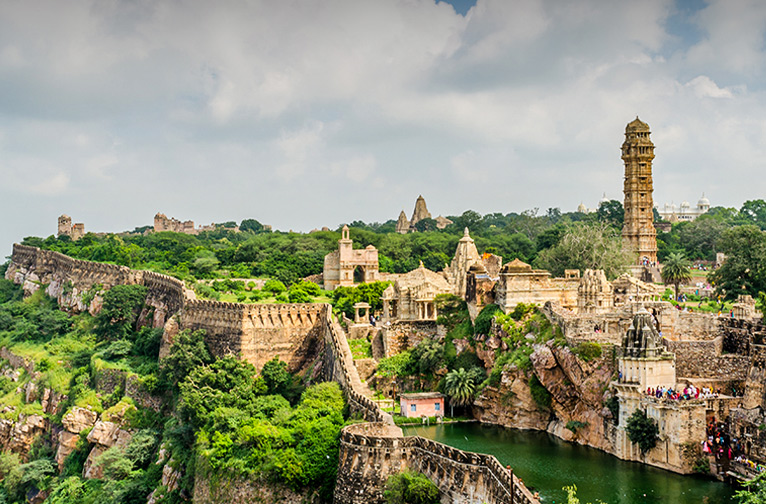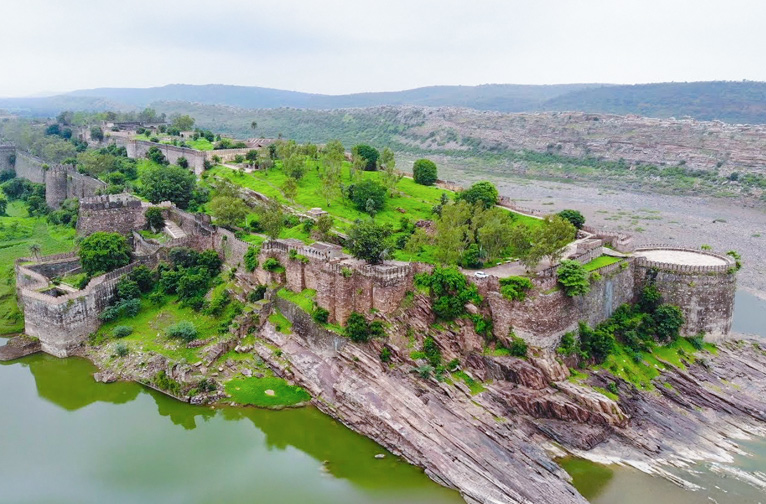The annals of Rajasthan have long been pondered for the valiant exploits of its warrior kings, who have defied the odds to protect their land, wealth, and women from invaders. Compelling stories have emerged about the fortresses that they built and the role these forbidding citadels played. Intertwining their military might with legendary heroics, rivalries, tales of chivalry, and romance, these fortresses can be found perched on lofty hilltops, by riversides, on desert lands, or in densely forested enclaves.
In 2013, UNESCO recognized six of these forts as a serial heritage World Heritage Site, under the collective name of "Hill Forts of Rajasthan". The forts included in this acclaim are Amber, Jaisalmer, Chittorgarh, Kumbhalgarh, Ranthambore, and Gagron. The eclectic architecture of the forts, some of whose sprawl could reach about 20 km in circumference, reflects the power and the relative political independence of the Rajput princely states between the 8th and 18th centuries. These fortresses were a self-contained world, complete with palaces and housing communities, bazaars and trading centres, temples and stepwells. They were flourishing centres of culture and commerce as well.
Let’s take a peek into this world
Amber Fort
Streams of visitors down the ages have been familiar with the splendours of the Amber Fort, which lies just a short drive away from the state capital of Jaipur. Built by Rajput Raja Man Singh in the 16th century, Amer served as the bastion of the Kachwaha Rajputs before Jaipur was replaced as their new capital in 1727 by Maharaja Sawai Jai Singh II.
Set atop a lofty cliff above the Maota Lake, Amer Fort can be accessed by car through the humongous Suraj Pol. The adventurous of heart can hike it up. From your lofty perch, you can also spot Jaigarh Fort, which houses the world’s largest cannon on wheels. Rumour refuses to die down that Jaigarh Fort was the secret hiding place of the ancient treasury of the Kachwaha rulers.
The magic and mystique of Amer’s gorgeous Sheesh Mahal, or palace of mirrors, still holds visitors in thrall centuries on. A lighted candle gets reflected a thousand-fold in the forest of mirrors that embellish its interiors, transforming it into a fairytale space of infinite beauty.
Chittorgarh Fort


Formerly the bastion of the Sisodia clan, it gained immortal fame for its three historical sieges— in 1303, 1535, and 1568. The historic splendour of Chittor, and its legends of chivalry and valour, are well intertwined with folklore that resonates through Rajasthan’s rich cultural offerings to this day. Visitors are thrilled to find a mass of architectural remains that have survived the march of time from as early as the 8th century to the 16th century at the site. These include palaces, temples, wells, and two superb victory towers. Unmissable too are the commonly cited stories, such as the obsession of the Sultan of Delhi, Alauddin Khilji, for Chittor’s brave and beautiful Rani Padmini, wife of King Ratan Rawal Singh. The brave queen chose to commit Jauhar, or ritual suicide, with her court ladies, rather than be taken by him as war booty during the siege of Chittor. What continues to intrigue us are the various versions of the history of Rani Padmini, which refuse to be laid at rest.
Jaisalmer Fort
The beautiful Sona Kila or Golden Fort of Jaisalmer has had its fair share of wars with the climate to survive in the Thar Desert. This living fort, built with the local golden sandstone, is remarked too for its stunning havelis and the group of Jain temples with their sumptuous carvings. Places to visit include the Patwon ki Haveli, Nathmalji’s Haveli, and the 19th-century Salim Singh’s Haveli; the 20th-century Badal Nivas Palace, the Sarvotttam Vilas Palace with exquisite glass mosaic and blue tile work, and the 18th-century Moti Mahal. Built by the town’s rich merchants between the 15th–16th centuries are the Chandraprabhu, Parasnath, Shitlanath, Sambhavanath, Shantinath, Kunthunath, and Rikhabdev Jain temples.
Kumbhalgarh Fort
It is home to the world’s second-largest fortification wall after the Great Wall of China. Apart from a palace that was added by Maharaja Fateh Singh, Kumbhalgarh Fort was built in a single process. The mighty sprawl of the 36 km long wall has become a popular site for an annual half-marathon race. Its width was big enough to allow eight horses to walk abreast on the wall. Built by Rana Kumbha in the 15th century, the only time its defences could be breached was by the combined armies of the Mughal and of Amber because the water had been poisoned. The fort, which houses over 360 Hindu and Jain temples, apart from the beautiful Badal Mahal, is considered the second most significant citadel in the Mewar region after Chittorgarh. It was also the birthplace of the legendary Rajput warrior king Maharana Pratap. It lies around 80 km away from Udaipur.
Ranthambhore Fort
Visitors travelling to Ranthambore National Park cannot miss the compelling visuals of this stunning fortress rearing into the skyline from its forested hilltop. While sightings in its precincts of the apex predator, the tiger, are always a priority, lovers of history and heritage can still marvel at the remnants of the palace of Hammir, one of its oldest surviving structures. The fort is also home to several ruined shrines, weather-battered Islamic tombs and a living Ganesh temple.
Gagron Fort


Commissioned by Raja Bijaldev of the Paramar dynasty in 1195, Gagron Fort is protected on three sides by the confluence of the Ahu and Kali Sindh rivers. The unique hill and water fort lies just 10 km away from Jhalawar town and 95 km from Kota. With the Mukundara hills in the Vindhya mountain range as a beautiful backdrop, the rugged fort is a largely unvisited sentinel with memories locked in of its glory days when it endured 14 battles and two tragic incidents of Jauhar. Amongst the ancient structures that remain are several sacred spots such as the Madhusudan temple, Dwarkadhish temple, Hanuman temple, Madanmohan temple, Shiva temple, Durga temple, and Ganesha temple, the dargah of Sufi saint Mitheshah or Khwaja Hamid Uddin Chisti, and a mosque. Other places to explore are the Badal Mahal, Rang Mahal, Barudkhana, Sheesh Mahal, Diwan-e-khas, Diwan-e-aam, Nakkar-khaana etc. It also features the monastery of Saint Pipa, a contemporary of Saint Kabir and disciple of Saint Ramanand.
The mysteries and intrigues that abound around Rajasthan’s forts is an endless saga; it’s one of the most thrilling aspects of their allure— and worthy of a deep dive for many more adventures of the historic kind in ‘Royal’ Rajasthan.